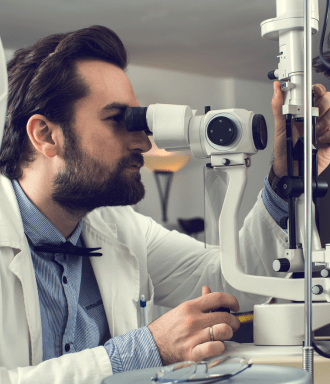
Cataract Surgery
Today’s cataract lens technology can correct nearsightedness, farsightedness and astigmatism.


Cataract Surgery at a Glance
What is Cataract Surgery with Vision-Correcting IOLs?
Cataract surgery removes the clouded natural lens and replaces it with an artificial plastic lens. Today’s lens technology enables cataract patients to not only replace their clouded lens with a clear plastic lens, but also correct other vision issues such as nearsightedness, farsightedness, and astigmatism. Working with your ophthalmologist, you can customize the procedure to your personal vision needs using today’s advanced intraocular lens technologies. The process of cataract surgery is essentially the same for everyone:
- As in any major surgical procedure, the operating room is a sterile environment.
- The majority of lens replacement procedures are done under local, topical anesthesia – eye drops to numb the surface of your eye. You are awake for the procedure, but your vision will be very blurry.
- A nurse may give you some medication to help keep you calm. You may also be placed on an IV of fluids and a heart rate monitor.
- A drape will be placed around your face so that only the eye to be operated on is visible.
- Most people feel no pain during the procedure, which usually lasts 15 to 30 minutes.
- The surgeon will make a small incision in the cornea with either a hand-held blade or a laser machine. In most cases, the incision is so small that stitches are not required.
- A small ultrasonic probe, a laser or a combination of the two is used to break up and remove the damaged lens. The new lens is then inserted where there old cloudy lens was located in the eye.
- Once the surgery is complete, the surgeon will cover the eye with a bandage or shield to protect it during the healing process.
- After a short recovery period, you can have someone drive you home.
There are a few lens options for lens replacement surgery. Which intraocular lens (IOL) is right for you depends on your lifestyle as well as your vision needs. Your ophthalmologist should discuss your options and help you choose between:
Standard or Monofocal lenses:
These lenses correct for one range of focus vision only – either near or distance, but not both. The patient will continue to rely on corrective glasses or contacts for the uncorrected range of vision as well as astigmatism.
Multifocal or accommodative intraocular lenses:
Designed to give presbyopia and cataract patients clear vision for both near and far objects, so you are less dependent on glasses.
Toric intraocular lenses:
A monofocal lens that also treats astigmatism. Toric lenses also help correct distance vision, but you will likely require glasses for reading.
Light adjustable intraocular lenses:
Specialized lens technology that customizes its focusing power through a series of short office-based light treatment procedures after cataract surgery.
IOL monovision:
Two different lenses are used; one to correct near vision in one eye and one to correct distance vision in the other. The brain coordinates the two distances, giving cataract patients vision that reduces the need for glasses of any kind. Prior to this procedure, the ophthalmologist will provide you with a trial set of monovision corrective contact lenses to help predict your brain’s ability to coordinate monovision.

Am I a Candidate for Cataract Surgery with Vision-Correcting IOLs?
If you are a good candidate for cataract surgery, it is likely you are a candidate for today’s advanced vision-correcting intraocular lens technology. Your optometrist and/or ophthalmologist should perform a comprehensive eye exam to check the overall health of your eyes, evaluate whether there are reasons why you should not have surgery and identify any risk factors you might have.
As part of your comprehensive eye exam, a refraction will be performed to determine the amount of nearsightedness, farsightedness, and/or astigmatism you have prior to surgery. Other measurements will be taken to help your cataract surgeon select the proper power of the intraocular lens and give you the best vision possible after surgery.
Be aware that not everyone is a good candidate for vision-correcting IOLs, and choosing some IOL technologies will increase the out-of-pocket cost of your cataract surgery, since the added cost of these advanced lens implants may not be covered by Medicare or other insurance plans. It is important to discuss your options with your surgeon.
Is Cataract Surgery with Vision-Correcting IOLs Safe?
Cataract surgery is a very safe procedure, with nearly 98 percent being performed without serious complications. In fact, a recent study of more than 200,000 Medicare beneficiaries who underwent cataract surgery between 1994 and 2006 found that 99.5 percent of patients had no severe postoperative complications. Advances in surgical tools and techniques are helping to further reduce the already rare risk of serious complications from cataract surgery. All cataract surgeries involve the implantation of an artificial lens – called an intraocular lens or IOL. Therefore, cataract surgery with vision-correcting intraocular lens technology carries a similarly low-risk profile of all cataract surgery. That said, all surgery comes with a degree of risk – even a very small one – and you and your eye surgeon should discuss your procedure in detail so you can make the best decision for you and your vision.
While complications after cataract surgery are uncommon, the good news is that most can be treated successfully. Your personal medical history and eye health may contribute significantly to your risk of complications from cataract surgery. Some of the risks of cataract surgery include:
- Inflammation and/or infection
- Bleeding
- Swelling
- Retinal detachment
- Glaucoma
- Posterior capsule opacity
- Loss of vision
A potential complication of cataract surgery with vision-correcting IOLs is residual halos, glare, and blurry vision specifically from the placement of the lens or the lens itself. It is important to discuss all of your medical history and, specifically, any eye problems you may have before making the decision to have cataract surgery.

Essential Reads:
Cataract Surgery
Ready to take the next step?
Schedule a consultation today.






